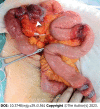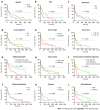Small intestinal angiosarcoma on clinical presentation, diagnosis, management and prognosis: A case report and review of the literature
- PMID: 36688020
- PMCID: PMC9850938
- DOI: 10.3748/wjg.v29.i3.561
Small intestinal angiosarcoma on clinical presentation, diagnosis, management and prognosis: A case report and review of the literature
Abstract
Background: Angiosarcoma is a highly malignant soft-tissue sarcoma derived from vascular endothelial cells that mainly occurs in the skin and subcutaneous tissues. Small-intestinal angiosarcomas are rare, and the prognosis is poor.
Case summary: We reported a case of primary multifocal ileal angiosarcoma and analyze previously reported cases to improve our understanding of small intestinal angiosarcoma. Small intestinal angiosarcoma is more common in elderly and male patients. Gastrointestinal bleeding, anemia, abdominal pain, weakness, and weight loss were the common symptoms. CD31, CD34, factor VIII-related antigen, ETS-related gene, friend leukemia integration 1, and von Willebrand factor are valuable immunohistochemical markers for the diagnosis of small-intestinal angiosarcoma. Small-intestinal angiosarcoma most commonly occurs in the jejunum, followed by the ileum and duodenum. Radiation and toxicant exposure are risk factors for angiosarcoma. After a definite diagnosis, the mean and median survival time was 8 mo and 3 mo, respectively. Kaplan-Meier survival analysis showed that age, infiltration depth, chemotherapy, and the number of small intestinal segments invaded by tumor lesions were prognostic factors for small intestinal angiosarcoma. Multivariate Cox regression analysis showed that chemotherapy and surgery significantly improved patient prognosis.
Conclusion: Angiosarcoma should be considered for unexplained melena and abdominal pain, especially in older men and patients with a history of radiation exposure. Prompt treatment, including surgery and adjuvant chemotherapy, is essential to prolonging patient survival.
Keywords: Angiosarcoma; Case report; Diagnosis; Pathological features; Prognosis; Small intestine.
©The Author(s) 2023. Published by Baishideng Publishing Group Inc. All rights reserved.
Conflict of interest statement
Conflict-of-interest statement: The authors declare that they have no conflict of interest to disclose.
Figures







References
-
- Zhang Y, Chen Y, Li J, Li S, Wu Y, Zhan D, Wen X, Wang M. Poor prognosis of primary duodenum angiosarcoma: a case report. ANZ J Surg. 2021;91:E600–E602. - PubMed
-
- Li R, Ouyang ZY, Xiao JB, He J, Zhou YW, Zhang GY, Li Q, Gu H, Leng AM, Liu T. Clinical Characteristics and Prognostic Factors of Small Intestine Angiosarcoma: a Retrospective Clinical Analysis of 66 Cases. Cell Physiol Biochem. 2017;44:817–827. - PubMed
Publication types
MeSH terms
Substances
LinkOut - more resources
Full Text Sources
Medical

